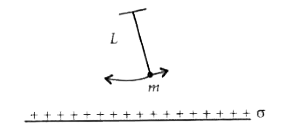A small ball of mass m=21g suspended by a insulating thread at a height h=12cm from a large horizontal conducting plane performs small oscillations (figure) . After a charge q had been imparted to the ball, the oscillation period changed η=2.0 times. Find q.

In the absence of the charge, the oscillation period of the ball
T=π√l/g
when we impart the charge q to the ball, it will be influenced by the induced charges on the conducting plane. From the electric image method the electric force on the ball by the plane equals q24πɛ0(2h)2 and is directed downward. Thus in this case the effective acceleration of the ball
g′=g+q216πε0mh2
and the corresponding time period
T′=2π√lg′=2π
⎷lg+q216πε0mh2
From the condition of the problem
T=ηT′
So, T2=η2T'2 or 1g=η2⎛⎜
⎜⎝1g+q216πε0mh2⎞⎟
⎟⎠
Thus on solving
q=4h√πε0mg(η2−1)=2μC
Topper's Solved these Questions
- OSCILLATIONS AND WAVESBook:IE IRODOV, LA SENA & SS KROTOVChapter:OSCILLATIONS AND WAVESExercise:Electric Oscillations
Explore 56 Videos
- OSCILLATIONS AND WAVESBook:IE IRODOV, LA SENA & SS KROTOVChapter:OSCILLATIONS AND WAVESExercise:Elastic Waves
Explore 39 Videos
- OPTICSBook:IE IRODOV, LA SENA & SS KROTOVChapter:OPTICSExercise:Exercise
Explore 2 Videos
- PHYSICAL FUNDAMENTALS OF MECHANICSBook:IE IRODOV, LA SENA & SS KROTOVChapter:PHYSICAL FUNDAMENTALS OF MECHANICSExercise:Relativistic Mechanics
Explore 49 Videos
Similar Questions
A small positively charged ball of mass m is suspended by an insulating thread of length L. This ball remains in equilibrium with string horizontal when another small charged ball is placed exactly at a distance L below the point of suspension of the first ball. The second ball is slowly moved away from the first ball to a far away point. (The second ball is moved horizontally so that the first ball does not accelerate). As a result the first ball lowers down to the original position of the second ball and the string become vertical. Find the work done by the external agent in removing the second ball.

View SolutionA small ball is suspended over an infinite horizontal conducting plane by means of an insulating elastic thread of stifiness k. As soon as the ball was charged it decended by xcm and its separation from the plane become equal to l. Find the charge of the ball.
View Solution
Knowledge Check
The bob of a pendulum of mass 'm' suspended by an inextensible string of length L as shown in the figure carries a small charge 'q' . An infinite horizontal plane conductor with uniform surface charge density sigma1 is placed below it . What will be the time period of the pendulum for small amplitude oscillations ?
 A2π ⎷L(g−mgε0σ)B ⎷L(g−mgε0)C12π ⎷L(g−qσε0m)D2π ⎷L(g−qσε0m)
A2π ⎷L(g−mgε0σ)B ⎷L(g−mgε0)C12π ⎷L(g−qσε0m)D2π ⎷L(g−qσε0m)A particle of mass 'm' and charge 'q' is suspended from the ceiling with the help of an insulating wire of length 'l'. It is placed in an uniform electric field as shown in figure. Then the time period of oscillation is
_2019_CBT6_E01_041_Q01.png) A ⎷l√g2+(qEm)2B2π ⎷l√g2+(qEm)2C2π ⎷l√g2+(qEm)D2π ⎷l√g2−(qEm)2
A ⎷l√g2+(qEm)2B2π ⎷l√g2+(qEm)2C2π ⎷l√g2+(qEm)D2π ⎷l√g2−(qEm)2A pith ball carrying a charge of 3×10−10C is suspended by an insulated thread of length 50cm.When a uniform electric filed is applied in a horizontal direction , the ball is found to deflect by 2cm from the vertical. If the mass of the ball is 0.5gm , the intensity of the electric field is :
A6.6×105N/CB3.3×105N/CC9.9×105N/CD1.1×105N/C
Three small balls, each of mass 10 g , are suspended from a common point by 1-m silk threads . The balls are identically charged and hung at the corners of an equiliteral triangle of 0.1 m. What is the charge on each ball ?
View SolutionThree identical small balls, each of mass 0.1 g, are suspended at one point on silk thread having a length of l=20cm . What charges should be imparted to the balls for each thread to form an angle of α=30∘ with the vertical?
View SolutionA small ball of mass m having charge q is suspended by a string of length L. Another identical ball having the same charge is kept at the point of suspension. Determine the minimum horizontal velocity which should be imparted to ball at lowest point so that it can make complete revolution.
View SolutionA steel ball of mass m=50g falls from the height h=1.0m on the horizontal surface of a massive slab. Find the cumulative momentum that the ball imparts to the slab after numerous bounces, if every impact decreases the velocity of the ball η=1.25 times.
View SolutionA spherical ball of mass m and radius r rolls without slipping on a rough concave surface of large radius R. It makes small oscillations about the lowest point. Find the time period.
View Solution